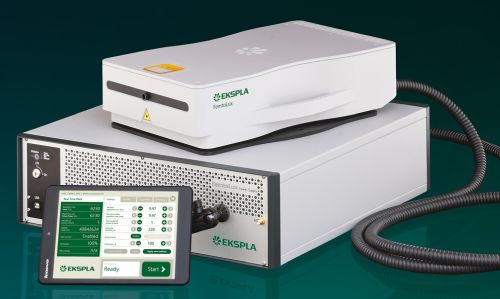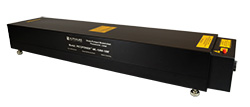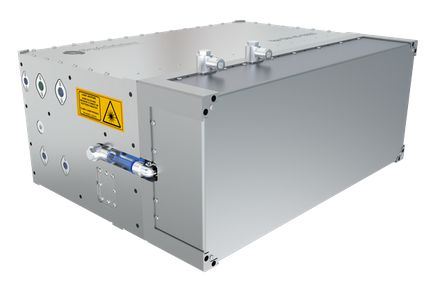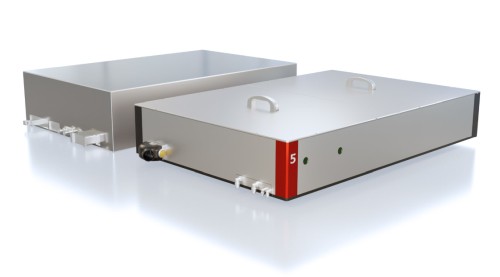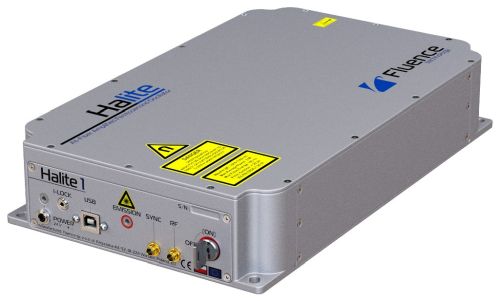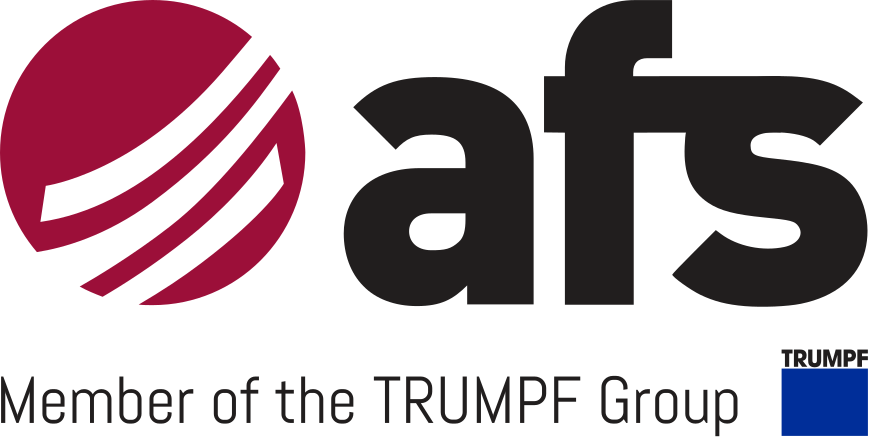ultrafast lasers (original) (raw)
Definition: lasers emitting ultrashort pulses
Alternative terms: ultrashort pulse lasers, femtosecond lasers, picosecond lasers
Categories:  laser devices and laser physics,
laser devices and laser physics,  light pulses
light pulses
- light sources
- lasers
* solid-state lasers
* diode-pumped lasers
* lamp-pumped lasers
* distributed feedback lasers
* dye lasers
* gas lasers
* free-electron lasers
* radiation-balanced lasers
* cryogenic lasers
* visible lasers
* eye-safe lasers
* infrared lasers
* ultraviolet lasers
* X-ray lasers
* upconversion lasers
* Raman lasers
* high-power lasers
* multi-line lasers
* narrow-linewidth lasers
* tunable lasers
* pulsed lasers
* ring lasers
* seed lasers
* ultrafast lasers
* picosecond lasers
* femtosecond lasers
* mode-locked lasers
* mode-locked fiber lasers
* mode-locked diode lasers
* titanium–sapphire lasers
* industrial lasers
* scientific lasers
* alignment lasers
* medical lasers
* space-qualified lasers
* miniature lasers
* OEM laser modules
* lasers for material processing
* lasers for quantum photonics
* lasers for Raman spectroscopy
* (more topics)
- lasers
Related: ultrafast laser physicspulse generationmode lockingpassive mode lockingmode-locked lasersKerr lens mode lockingtitanium–sapphire lasersfemtosecond laserspicosecond lasersultrashort pulsesultrafast amplifiersoptical samplingAll-in-One Ultrafast Laser Systems
Page views in 12 months: 2485
DOI: 10.61835/rx4 Cite the article: BibTex BibLaTex plain textHTML Link to this page! LinkedIn
Content quality and neutrality are maintained according to our editorial policy.
📦 For purchasing ultrafast lasers, use the RP Photonics Buyer's Guide — an expert-curated directory for finding all relevant suppliers, which also offers advanced purchasing assistance.
Contents
What are Ultrafast Lasers?
The term ultrafast lasers is used for different kinds of lasers and laser systems:
- There are mode-locked lasers emitting ultrashort pulses, i.e. light pulses with durations of femtoseconds or picoseconds: mostly below 100 ps, often even well below 100 fs. These are nearly always mode-locked lasers, although e.g. gain switching can also provide ultrashort pulses in the picosecond domain. Typical pulse repetition rates of ultrafast lasers are of the order of 100 MHz, but it is also possible to have only a few megahertz or many gigahertz.
- In some cases, one employs cavity dumping to a mode-locked laser for obtaining pulse trains with higher pulse energy at a lower pulse repetition rate (e.g. 1 MHz instead of 100 MHz).
- The term is also used for ultrafast laser systems comprising an ultrafast laser and some kind of pulse amplifier. In some cases, the high repetition rate pulse train of a mode-locked laser is just amplified to a higher power level, raising the pulse energy as much as the average power. In other cases, the pulse repetition rate is substantially or even dramatically reduced with a pulse picker. The pulse energy obtainable with amplification can then be much higher; in extreme cases, it is multiple joules, and the peak power can be extremely high (in the terawatt or even petawatt region).
A more precise but less common term is actually ultrashort pulse lasers; such lasers utilize ultrafast processes and emit light with very fast changes in optical power, but are strictly speaking not ultrafast themselves.
Types of Ultrafast Lasers
The most important types of ultrafast lasers (without amplifiers) are briefly listed in the following:
- titanium–sapphire lasers, often Kerr lens mode-locked, can generate the shortest pulses with durations down to approximately 5 fs. Their average output power of typically hundreds of milliwatts, combined with a pulse repetition rate of e.g. 80 MHz and a pulse duration of some tens of femtoseconds or shorter, leads to an enormous peak power. Unfortunately, Ti:sapphire lasers require intense pump light from some green laser, which makes them more complex and expensive.
- There are various kinds of mode-locked diode-pumped bulk lasers, based on, e.g., ytterbium-doped (crystals or glasses) or chromium-doped laser crystals. They are often passively mode-locked with a SESAM, a semiconductor saturable absorber. Although the pulse durations are not as short as those possible with Ti:sapphire lasers, there are diode-pumped ultrafast lasers covering wide parameter regions in terms of pulse duration, pulse repetition rate, and average power (see below).
- Fiber lasers based on rare-earth-doped glass fibers can also be passively mode-locked, e.g. using nonlinear polarization rotation or a SESAM. Due to fiber nonlinearities, they are more limited than bulk lasers in terms of average power and particularly peak power, but may conveniently be combined with a fiber amplifier. The article on mode-locked fiber lasers gives more details.
- Mode-locked dye lasers are still sometimes used, particularly as tunable lasers in unusual wavelength regions. However, they have mostly been replaced by solid-state lasers.
- Mode-locked diode lasers can either be monolithic devices or external-cavity diode lasers, and may be actively, passively or hybrid mode-locked. Typically, mode-locked diode lasers operate at high (multi-gigahertz) pulse repetition rates with moderate pulse energy, and are used in optical fiber communications.
See the article on ultrafast amplifiers for common type of amplifiers, including both laser amplifiers and parametric amplifiers.
Physical Phenomena
The following phenomena of ultrafast optics and ultrafast laser physics are most relevant in ultrashort pulse lasers:
- The Kerr effect leads to self-phase modulation, which is a refractive index change which instantly follows the pulse intensity. It also allows for Kerr lens mode locking. Related nonlinearities such as Raman scattering and self-steepening occur when the nonlinearity has a finite response time.
- Chromatic dispersion has a great influence on pulse formation — also on the effect of optical nonlinearities on the pulse formation.
- Saturable absorbers used for passive mode locking introduce optical losses which are reduced for high optical intensities. Even for so-called slow absorbers, the change in losses usually recovers within picoseconds after the passage of a pulse.
The research area of ultrafast lasers and their applications is called ultrafast laser physics and ultrafast optics. It deals with all kinds of effects occurring in these lasers, but also with phenomena which can be investigated using ultrashort laser pulses. Examples of such application areas are high-intensity physics (→ high harmonic generation), frequency metrology, laser spectroscopy, and terahertz science.
Developments in the Field of Ultrashort Pulse Generation
The field of ultrashort pulse generation has had roughly three decades to develop and can thus be considered relatively mature. Some of the most important developments which are more or less finished are listed in the following:
- Although dye lasers dominated the field in earlier times, these have been nearly completely replaced by long-lived, powerful and efficient diode-pumped solid-state lasers. Basically only for a few special spectral regions are dye lasers still used. Their competitors are synchronously pumped optical parametric oscillators.
- An important technological development is that of semiconductor saturable absorber mirrors (SESAMs) [11] as very versatile devices mainly for passive mode locking. Although such devices have been used since the early 1990s, their benefits were later greatly increased by improved SESAM designs, a wider range of available semiconductor materials, improved fabrication techniques, and particularly by a much improved understanding of their optimum use – particularly in extreme parameter regions. Today, SESAMs can be used in very wide parameter regions concerning pulse duration, laser wavelength and power level.
- The pulse duration achievable with solid-state lasers (without external pulse compression) has come down to the region around 5.5 fs, corresponding to about two optical oscillation cycles (few-cycle pulses) [5, 6]. This is done with Kerr-lens mode-locked titanium–sapphire lasers. The resulting optical spectra are extremely wide, with ultrabroad bandwidths of the order of an octave (octave-spanning spectra), even though the full width at half-maximum (FWHM) is usually somewhat smaller.
- Further shortening of ultrashort pulses is possible with pulse compression techniques. Advanced compression setups allow for pulse durations below 3 fs (although the concept of pulse duration becomes nontrivial in this parameter regime). The technique of high harmonic generation even allows the generation of attosecond pulses in the extreme ultraviolet spectral region.
- Diode-pumped solid-state lasers, particularly those based on ytterbium, have been developed for extremely high average output powers [10, 12, 14, 15] and for pulse energies of multiple microjoules [13]. This progress was based on thin-disk laser heads, an improved understanding of Q-switching instabilities, damage issues of saturable absorbers, resonator design, and most importantly a solid understanding of the complicated interplay of all these aspects.
- Both Nd:YVO4 lasers and erbium-doped bulk lasers with miniature resonators have been developed for the generation of pulse trains with extremely high pulse repetition rates of tens of gigahertz or even well above 100 GHz [9]. This required mainly optimized resonator designs and an improved understanding of Q-switching instabilities. Such lasers emit picosecond pulses with moderate average output powers, normally well below 1 W.
- After many years where mode-locked semiconductor lasers were limited to fairly low output powers, novel optically pumped passively mode-locked vertical external cavity surface-emitting lasers (VECSELs) have been demonstrated to be suitable for a combination of high (multi-gigahertz) pulse repetition rates with multi-watt average output powers.
- Nonlinear frequency conversion (e.g. with optical parametric oscillators) has been proven to work well even at very high average power levels. In some respects, the setups can even become simpler than those of lower-power devices. Access to a wider range of wavelengths is crucial for some applications, such as laser projection displays (→ RGB sources).
Further developments can be expected in the near future:
- The choice of solid-state gain media is still growing. New laser crystal materials with interesting properties have been developed, which promise superior performance or even entirely new achievements. For example, new ytterbium-doped laser gain media such as sesquioxides and tungstates could prove even better than Yb:YAG for thin-disk lasers with even higher powers in ultrashort pulses, or for shorter pulses at high power levels. On the other hand, ultrabroadband gain media such as Cr2+:ZnSe should be suitable for the generation of pulses with 20 fs duration or less in the spectral region around 2.7 μm, even though this expectation has not been fulfilled, without the reason being very clear so far. (Excessive nonlinearity is perhaps an explanation.)
- Mode-locked fiber lasers [18] have been showing impressive advances in performance for several years. It is to be expected that this development will continue, also for commercial lasers, although some fundamental limitations arise from fiber nonlinearities. Most promising is the potential for cost reduction in cases where performance requirements are moderate and production quantities are high. See also the article on fiber lasers versus bulk lasers.
- Ultrafast amplifier devices for lower repetition rates (mainly diode-pumped regenerative amplifiers) will become increasingly important for laser material processing, e.g. in the form of laser micromachining.
- Passively mode-locked VECSELs (see above) surely have the potential for significant further advances in performance, particularly in the area of multi-gigahertz repetition rates combined with multi-watt output powers and/or sub-picosecond pulse durations. Furthermore, the application of wafer-scale technologies may allow mode-locked VECSELs to be fabricated at very low cost, making possible new application fields with stringent cost limits.
Concerning applications, it is to be expected that many more ideas will be generated. Note that certain parameter regions have only recently be accessible with laser sources, so that those working on the application side can start thinking about using such sources, some of which should soon become commercially available. It appears realistic to expect that ultrafast technology will gain further importance and permit new exciting developments.
Applications of Ultrafast Lasers
The output of an ultrafast laser has various remarkable properties which are of interest for a wide range of applications in fundamental research. There is also a wide range of industrial applications, which have become more attractive with the advent of compact, powerful and cost-effective mode-locked lasers.
The applications include very diverse areas, and exploit different aspects of ultrashort pulses; some examples:
- In some cases, the crucial property is the ultrashort pulse duration itself — for example, for pump–probe measurements, for distance measurements with lasers with the time-of-flight method, for the characterization of high-speed electronics with electro-optic sampling, the generation and detection of terahertz radiation, or for optical fiber communications with soliton pulses.
- In other cases, one exploits the very high peak power, which results from the strong temporal concentration of a moderate amount of optical energy. That combined with the high focusability can result in extremely high optical intensities. Under such conditions, the material hit on a work sample may be evaporated very quickly before the induced heat can be dissipated via thermal conduction. This is particularly relevant for industrial laser material processing of small parts (laser micromachining) or with very high quality, also for waveguide writing, and similarly in some medical applications such as eye surgery (femto-LASIK) and other forms of microsurgery. Another example is laser-induced breakdown spectroscopy (LIBS).
- Further, high peak powers greatly facilitate the simple and efficient nonlinear frequency conversion of light pulses, e.g. for high-power RGB displays (→ RGB sources) and for laser spectroscopy. Particularly extreme optical intensities are used in some fundamental science experiments and in laser fusion research.
- In laser microscopy and tomography, one often exploits the temporal and spatial concentration of optical energy. Special variants (STED microscopy), which work only with ultrashort pulses, can even achieve sub-wavelength resolution.
- Sometimes it is highly relevant that there is a high degree of coherence between subsequent pulses. As a result, the optical spectrum has the form of a frequency comb. The low-noise properties of such frequency combs are exploited in optical metrology, e.g. for building extremely precise optical clocks. The role of a frequency comb source in such a clock can e.g. be to related a highly stable optical frequency to a microwave frequency, or to compare different optical frequencies.
- The broad optical bandwidth of ultrashort pulse sources is sometimes relevant, e.g. for avoiding laser speckle effects in displays, or for high resolution in coherence radar and optical coherence tomography — although in most cases one would prefer a simpler solution such as a wavelength-swept laser.
Suppliers
Sponsored content: The RP Photonics Buyer's Guide contains 119 suppliers for ultrafast lasers. Among them:
⚙ hardware
MPBC offers two distinct product lines in the ultrafast regime, our femtosecond fiber lasers and our picosecond fiber lasers.
These lasers provide outstanding performance, offering linearly polarized, near-transform-limited pulses with excellent beam quality. They are compact, reliable, and require low maintenance, available either as seeders for high-power laser systems or complete laser systems. Our ultrafast fiber lasers come with a wide range of repetition rates, wavelengths, and output powers, making them suitable for a variety of advanced applications.
⚙ hardware
With more than 20 years of experience, TOPTICA provides high-repetitive femtosecond lasers based on fiber laser technology. TOPTICA offers systems for OEM integrators as well as customized solutions for scientific customers, ranging from compact laser systems to tailored for specific applications, to customized high-power multi-watt laser systems.
TOPTICA offers several products fulfilling these requirements: ultrafast fiber lasers based on erbium (Er) and ytterbium (Yb) like the FemtoFiber smart, FemtoFiber ultra and FemtoFiber dichro series.
⚙ hardware
The current EKSPLA product line includes lasers providing picosecond and femtosecond pulses. The femtosecond laser line includes:
- the FemtoLux3 series microjoule class industrial fiber laser
- the Ultraflux series femtosecond tunable wavelength laser based on the novel OPCPA technology
- the FFS series compact fiber laser
Due to their excellent stability and high output parameters, EKSPLA scientific picosecond lasers established their name as “Gold Standard” among scientific picosecond lasers. The innovative design of a new generation of picosecond mode-locked lasers features diode-pumping‑only technology, thus reducing maintenance costs and improving output parameters. Second, third, fourth and fifth (on some versions) harmonic options combined with various accessories, advanced electronics (for streak camera synchronization, phase-locked loop, synchronization of femtosecond laser) and customization possibilities make these lasers well suited for many scientific applications, including optical parametric generator pumping, time-resolved spectroscopy, nonlinear spectroscopy, remote sensing and metrology.
💡 consulting🧰 development🎓 training💻 software

Dr. Paschotta is a distinguished expert, knowing in detail how ultrafast lasers work. He can help to develop such lasers, provide simulations (and software for that purpose), and offers tailored staff training courses.
⚙ hardware
Thorlabs manufactures an extensive selection of ultrafast lasers and related products for control and characterization. Applications from nonlinear excitation and amplifier seeding to THz and supercontinuum generation are served by a family of products covering a spectral range from 700 — 4500 nm. Our femtosecond laser offerings include fiber lasers, and our picosecond lasers include gain-switched and microchip lasers. Complementing these laser systems is a suite of ultrafast optics, including nonlinear crystals, chirped mirrors, low-GDD optics, and related products for pulse measurement, pre-compensation, and dispersion measurement.
⚙ hardware
The Stuttgart Instruments Primus is an ultrafast (fs) mode-locked oscillator, based on the solid-state technology. It provides a high average output power combined with a superior low noise level (shot noise limit above 300 kHz) and an excellent long-term stability.
The solid-state technology with 1040 nm central wavelength enables the excellent long-term stability by providing several watts of output power at 40 MHz pulse repetition rate and 450 fs pulse duration. Its superior low noise level reaches the shot noise limit above 300 kHz. In combination with the stability and output power, it enables ultrasensitive measurements and makes the Primus perfectly suited as pump source for frequency converters like the Stuttgart Instruments Alpha. The entire system is encapsulated in a solid CNC-cut and water-cooled housing, thus reaching excellent robustness against external perturbations.
⚙ hardware
Menlo Systems' femtosecond fiber lasers based on Menlo figure 9® patented laser technology are unique in regard to user-friendliness and robustness. We offer solutions for scientific research as well as laser models engineered for OEM integration. From the shortest pulses to highest average power beyond 10 watts and pulse energy beyond 10 μJ we have the solution for your application ranging from basic research to industrial applications in spectroscopy, quality control, and material processing.
⚙ hardware
The ALPHALAS product line of PICOPOWER series ultrafast lasers implements advanced methods for generating picosecond pulses, including active, passive or combined mode-locking. ALPHALAS is the only manufacturer that uses the patented and most advanced “Nonlinear Mirror” or “Stankov Mirror” mode-locking method based on second harmonic generation with practically unlimited power scaling.
The product line includes cavity-dumped mode-locked lasers, regeneratively amplified picosecond pulses with unsurpassed low jitter < 3.5 ps for pulses “on demand” and MW peak power. Optional harmonic wavelengths are also available.
The PICOPOWER-LD series of the proprietary picosecond diode lasers covers the range 375 nm to 2300 nm with picosecond pulses as short as 12 ps and high peak power more than 2 W for specific wavelengths. Numerous applications cover optical parametric generator pumping, nonlinear optics, spectroscopy time-resolved spectroscopy, remote sensing and material processing.
⚙ hardware
n2-Photonics offers the Lamiks lasers with:
- Pulse duration: <100 fs; <50 fs and <10 fs
- Power: up to 300 W
- Energy: 10 μJ and up to 3 mJ
- Repetition rate: up to 100 MHz
- Wavelength: 1030 nm
⚙ hardware
Radiantis manufacturers broadly tunable laser systems based on Optical Parametric Oscillators (OPOs). Our MHz repetition-rate femtosecond and picosecond lasers cover the visible and IR spectral regions. The laser systems include both a pump laser and the OPO in the same enclosure.
⚙ hardware
Serving North America, RPMC Lasers offers ultrafast lasers with UV to LWIR wavelengths (210 nm — 10,000 nm), including up to 5th harmonics, tunable, narrow linewidth, and broadband options for precision defense, medical, industrial, and research applications.
Ultrashort picosecond and femtosecond pulses deliver high energies and peak power, minimizing HAZ with cold ablation for excellent cut quality and advanced glass processing, enhanced by tunable rep rates and pulse widths.
Robust, customizable platforms provide tailored solutions with add-ons, integrating easily as OEM or turnkey systems, with extreme shock and vibration resilience for harsh environments.
Let RPMC help you find the right ultrafast laser today!
⚙ hardware
Bright Solutions has the NPS narrowband picosecond lasers:
- 1064, 532 or 355 nm
- 7-ps pulses at 40 MHz
- spectral width < 0.3 nm
- 10 mW average output power; custom Nps-1064-k2 with amplifier for 2 W output power
The NPS lasers are suitable for applications like OPO pumping, Raman or fluorescence spectroscopy and multimodal imaging.
⚙ hardware
Horizon is a next-generation supercontinuum fiber laser that delivers exceptional performance for spectroscopy and imaging. It's ultra-flat spectrum, free of spurious spectral peaks, spans an impressive spectral range of 450 to 2300 nm, providing < 3 W of average power and ≥ 250 mW average power in the visible range.
With outstanding spatial coherence, broad spectral coverage, and superior spectral flatness, Horizon outperforms traditional supercontinuum sources.
⚙ hardware
The VALO Series of ultrafast fiber lasers delivers exceptional performance for advanced applications requiring ultrashort pulse durations and high peak power. These compact, turn-key solutions are engineered with innovative fiber laser technology to produce pulse durations of less than 40 fs, making them suitable for a range of precision tasks.
Key features of the VALO Series include:
- Pulse duration of <40 fs
- Output power up to 2 W
- Very low noise levels
- Integrated pre-compensation dispersion module
These characteristics make the VALO lasers ideal for multiphoton imaging, advanced spectroscopy, and other demanding applications where precise pulse control and high peak power are critical.
⚙ hardware
NKT Photonics offers a wide range of ultrafast lasers. Our solid-state and fiber lasers are all maintenance-free and come in dust-sealed housing allowing for operation in the harshest environments.
⚙ hardware
Cycle supplies fiber-based systems with unique features and affordable prices:
- Cycle’s SONATA is a SESAM-free, all-PM, low-noise fiber laser with high environmental stability. It provides a dual fiber/free-space outputs at 1030 nm with clean and low-noise pulses. A chirped picosecond pulse is coming from fiber port for amplification and a second compressed free-space output allows detection and stabilization — ideal for ultrafast applications, amplifier seeding, and nonlinear microscopy. With optics and electronics integrated into a single compact unit, SONATA ensures a seamless, plug-and-play experience.
- The SOPRANO-CA is designed to carry out tasks such as multiphoton microscopy, spectroscopy, semiconductor testing and materials analysis. In addition to its low relative intensity noise, reliability and clean pulse shape, the SOPRANO-CA operates at a center wavelength of 1560 nm and typical pulse duration below 150 fs, establishing benefits in both industrial and scientific environments.
⚙ hardware
LIGHT CONVERSION has worldwide recognition for its industrial-grade Yb-based PHAROS, CARBIDE, and FLINT femtosecond lasers.
- The PHAROS series focuses on customizability, reliability, and process-tailored output parameters, providing pulse durations down to 100 fs and pulse energies up to 4 mJ.
- The CARBIDE series features a compact industrial design with both air- and water-cooled models, the latter reaching 120 W of output power for the fundamental wavelength and 50 W for UV radiation, while sustaining excellent output stability.
- The FLINT oscillators extend the parameter range with repetition rates of up to 100 MHz.
Together, these products cover a wide range of scientific, industrial, and medical applications.
⚙ hardware
The RUBRIComb™ Frequency Comb is built and optimized for leading lab hero experiments and rugged field use. 20G shock tested and capable of transferring sub-hertz linewidth stability. Stays phased locked for days, weeks, months, years.
RUBRIColor is a modular extension of the RUBRIComb™ platform that drives selectable wavelengths from 490 nm up to 2000 nm, offering a dramatic increase in leading lab hero experiments and rugged field use, thus driving reduced complexity while increasing stability for quantum computers, optical clocks, quantum sensors, and quantum networking.
⚙ hardware
Class 5 Photonics delivers ultrafast, high-power laser technology at outstanding performance to advance demanding applications from bio-imaging to ultrafast material science and attosecond science. Our robust optical parametric chirped pulse amplifiers (OPCPA) provide high-power, tunable femtosecond pulses at user-friendly operation.
Features of the White Dwarf OPCPA 5 W:
- compact and user-friendly
- CEP stability available
- pumped by Coherent Monaco industrial femtosecond laser
- high-performance, ultrafast OPCPA
- pump-probe configuration
- pumped by Yb-based laser up to 300 W and 3 mJ
- our award-winning flagship product
- highest average power OPCPA for demanding applications
- pumped by kW-class Yb:YAG Innoslab amplifiers or thin-disk lasers
⚙ hardware
Halite is a compact, single-box, all-fiber femtosecond laser, specifically designed to meet the most demanding applications in the field of neuroscience, biophotonics, microscopy and engineering. With pulses as short as <180 fs, average power up to 2 W at 1030 nm and the option of second harmonic generation at 515 nm, it is an irreplaceable tool in every lab that needs a reliable, turn-key, ultrafast light source. Thanks to its unique construction and SESAM-free technology it is a cost-effective solution that provides high pulse energy (up to 100 nJ) and an excellent beam quality. Halite’s industrial design facilitates easy integration with both experimental and commercial systems.
⚙ hardware
AFS’s customized kW average power and multi-mJ pulse energy ultrafast laser systems are based on AFS leading-edge fiber technology. They unite multiple main-amplifier channels using coherent combination, a technology which AFS has matured to an industrial grade. All essential parameters are software-controlled and can be tuned over a wide range, making them an extremely valuable tool for numerous application.
⚙ hardware
K2 Photonics’ K2-1000-mini is an ultra-compact, 1 GHz repetition rate femtosecond laser engineered for high-power, ultra-low noise operation. Designed for OEM integration, it offers unparalleled stability, making it ideal for optical frequency combs, dual-comb spectroscopy, nonlinear microscopy, amplifier seeding and high-precision metrology.
Key advantages:
- Compact & turnkey — all-in-one design (240 × 140 × 85 mm³) for easy integration.
- High power & short pulses — up to 3 W per comb, less than 100 fs pulse duration (depending on configuration) for demanding nonlinear applications.
- Ultra-low intensity and timing noise performance.
- Dual-comb ready — optional single-cavity dual-comb mode, enabling precise, high-speed spectroscopy and LiDAR without any locking electronics.
With its revolutionary GHz-class performance in a miniaturized footprint, the K2-1000-mini sets a new standard in precision laser technology, enabling cutting-edge research and industrial applications.
⚙ hardware
Menhir Photonics offers ultrafast mode-locked lasers at 1.5 μm (MENHIR-1550) and 1.0 μm (MENHIR-1030) wavelengths. These lasers feature:
- Pulse widths below 200 fs
- Pulse repetition rates from 142 MHz to 10 GHz
- Hermetically sealed units integrating both laser and electronics
- Ultra-low-noise performance
- High reliability and robustness for laboratory and harsh environments
- Options for fiber or free-space output
- Available in industrial and compact versions
⚙ hardware
The GDL Series represents the next generation industrial ultrafast lasers systems. With high power output and high pulse energy, ultrafast disk lasers enhance processing efficiency, unlocking new opportunities for advanced industrial applications of ultrafast lasers. Featuring a patented active beam path stabilization system, these GDL Series significantly improves stability for continuous 24/7 industrial operation. From core components like large-aperture Pockels cells and disk pump modules to intelligent software control, the entire laser system is indigenously developed domestically, ensuring total quality control and supply chain security.
Key performance parameters:
- Average power: 300 W at 1030 nm, or 150 W at 515 nm
- Pulse energy: 5 mJ / 3 mJ
- Pulse duration: 8 ps
- Pulse repetition rate: 50–150 kHz / 50–500 kHz
- Beam quality: _M_2 < 1.1
Bibliography
| [1] | F. Krausz et al., “Femtosecond solid-state lasers”, IEEE J. Quantum Electron. 28 (10), 2097 (1992); doi:10.1109/3.159520 |
|---|---|
| [2] | P. J. Delfyett et al., “High-power ultrafast laser diodes”, IEEE J. Quantum Electron. 28 (10), 2203 (1992); doi:10.1109/3.159528 |
| [3] | P. M. W. French, “The generation of ultrashort laser pulses”, Rep. Prog. Phys. 58, 169 (1995); doi:10.1088/0034-4885/58/2/001 |
| [4] | S. Backus et al., “High power ultrafast lasers”, Rev. Sci. Instrum. 69, 1207 (1998); doi:10.1063/1.1148795 |
| [5] | D. H. Sutter et al., “Semiconductor saturable-absorber mirror-assisted Kerr lens modelocked Ti:sapphire laser producing pulses in the two-cycle regime”, Opt. Lett. 24 (9), 631 (1999); doi:10.1364/OL.24.000631 |
| [6] | U. Morgner et al., “Sub-two cycle pulses from a Kerr-lens mode-locked Ti:sapphire laser”, Opt. Lett. 24 (6), 411 (1999); doi:10.1364/OL.24.000411 |
| [7] | C. Hönninger et al., “Ultrafast ytterbium-doped bulk lasers and laser amplifiers”, Appl. Phys. B 69, 3 (1999); doi:10.1007/s003400050762 |
| [8] | E. Sorokin et al., “Diode-pumped ultrashort-pulse solid-state lasers”, Appl. Phys. B 72, 3 (2001); doi:10.1007/s003400000464 |
| [9] | L. Krainer et al., “Compact Nd:YVO4 lasers with pulse repetition rates up to 160 GHz”, IEEE J. Quantum Electron. 38 (10), 1331 (2002); doi:10.1109/JQE.2002.802967 |
| [10] | E. Innerhofer et al., “60 W average power in 810-fs pulses from a thin-disk Yb:YAG laser”, Opt. Lett. 28 (5), 367 (2003); doi:10.1364/OL.28.000367 |
| [11] | U. Keller, “Recent developments in compact ultrafast lasers”, Nature 424, 831 (2003); doi:10.1038/nature01938 |
| [12] | F. Brunner et al., “Powerful RGB laser source pumped with a mode-locked thin-disk laser”, Opt. Lett. 29 (16), 1921 (2004); doi:10.1364/OL.29.001921 |
| [13] | S. V. Marchese et al., “Pulse energy scaling to 5 μJ from a femtosecond thin-disk laser”, Opt. Lett. 31 (18), 2728 (2006); doi:10.1364/OL.31.002728 |
| [14] | C. J. Saraceno et al., “Ultrafast thin-disk laser with 80 μJ pulse energy and 242 W of average power”, Opt. Lett. 39 (1), 9 (2014); doi:10.1364/OL.39.000009 |
| [15] | J. Brons et al., “Energy scaling of Kerr-lens mode-locked thin-disk oscillators”, Opt. Lett. 39 (22), 6442 (2014); doi:10.1364/OL.39.006442 |
| [16] | K. Sugioka and Y. Cheng, “Ultrafast lasers — reliable tools for advanced materials processing”, Light: Science & Applications 3, e149 (2014); doi:10.1038/lsa.2014.30 |
| [17] | T. Nubbemeyer et al., “1 kW, 200 mJ picosecond thin-disk laser system”, Opt. Lett. 42 (7), 1381 (2017); doi:10.1364/OL.42.001381 |
| [18] | M. E. Fermann, “Ultrafast fiber oscillators”, in Ultrafast Lasers: Technology and Applications (eds. M. E. Fermann, A. Galvanauskas, G. Sucha), Marcel Dekker, New York (2003), Chapter 3, pp. 89–154 |
| [19] | R. Paschotta and U. Keller, “Passively mode-locked solid-state lasers”, in Solid-State Lasers and Applications (ed. A. Sennaroglu), CRC Press, Taylor and Francis Group, LLC (2007), Chapter 7, pp. 259–318 |
| [20] | R. Paschotta, “Ultrakurzpuls-Festkörperlaser – eine vielfältige Familie”, Photonik 1 / 2006, p. 70 |
| [21] | R. Paschotta, “Laser sources for ultrashort pulses”, Laser Technik Journal 4 (1), p. 49 (2007) |
(Suggest additional literature!)

Questions and Comments from Users
Here you can submit questions and comments. As far as they get accepted by the author, they will appear above this paragraph together with the author’s answer. The author will decide on acceptance based on certain criteria. Essentially, the issue must be of sufficiently broad interest.
Please do not enter personal data here. (See also our privacy declaration.) If you wish to receive personal feedback or consultancy from the author, please contact him, e.g. via e-mail.
By submitting the information, you give your consent to the potential publication of your inputs on our website according to our rules. (If you later retract your consent, we will delete those inputs.) As your inputs are first reviewed by the author, they may be published with some delay.





